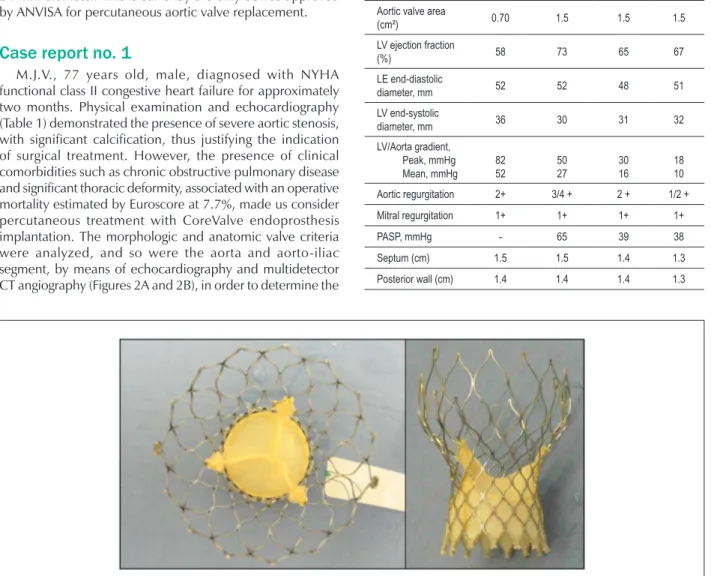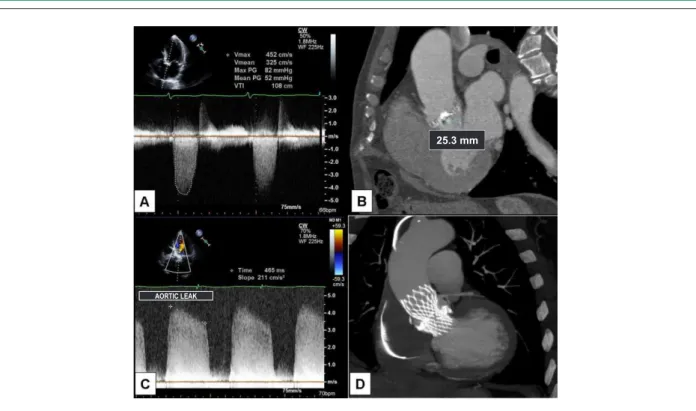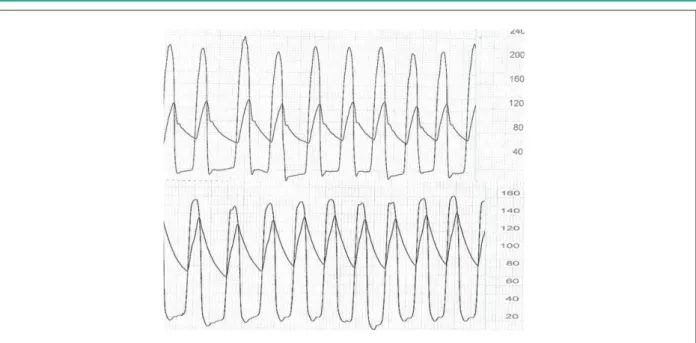Percutaneous Aortic Valve Replacement for the Treatment of Aortic
Stenosis. Early Experience in Brazil
Marco Antonio Perin, Fábio Sândoli de Brito Jr., Breno Oliveira Almeida, Marco Aurélio M. Pereira, Alexandre Abizaid,
Flávio Tarasoutchi, Eberhard Grube
Hospital Israelita Albert Einstein, São Paulo, SP - Brazil
Summary
Background: Percutaneous aortic valve replacement for the treatment of aortic stenosis is an available and efficient alternative for patients at high surgical risk, especially those with advanced age and comorbidities.
Objective: The authors report the first experience made in our midst with the use of the CoreValve endoprosthesis. Methods: In January 2008, two patients underwent percutaneous aortic valve replacement due to symptomatic aortic stenosis. They were selected for being elderly (77 and 87 years) and presenting comorbidities and a high surgical risk (EuroScore 7.7% and 12.1%).
Results: Percutaneous implantations of the CoreValve device were successfully performed. Enlargement of the valve area (from 0.7 to 1.5 cm2 and from 0.5 to 1.3 cm2) and reduction of the aortic transvalvular gradient (from 82 to 50 mmHg and from 94 to 31 mmHg) were observed immediately after the intervention. During hospital stay, permanent pacemaker implantation was required in both patients due to atrioventricular block. At six months, an even greater drop in the aortic transvalvular gradient (gradient < 20 mmHg) and remission of symptoms of heart failure (NYHA III to NYHA I) were observed.
Conclusion: The use of the CoreValve endoprosthesis for the treatment of aortic stenosis proved to be feasible and showed encouraging results in this early experience made in our midst. (Arq Bras Cardiol 2007;88(6):624-628)
Key words: Aortic valve stenosis/therapy; balloon dilatation; heart valve prosthesis.
Mailing address: Fábio Sândoli de Brito Jr. •
R. Dom Armando Lombardi 819/82 A, Vila Progredior - 05616-011 - São Paulo, SP - Brazil
E-mail: fsbrito@superig.com.br
Manuscript received October 05, 2008; revised manuscript received November 23, 2008; accepted November 28, 2008.
These findings have encouraged the development of percutaneous aortic valve replacement devices. In 2002, Alain Cribier7 successfully performed the first percutaneous
implantation, in humans, of an aortic valve bioprosthesis composed of three porcine pericardial leaflets mounted within a balloon-expanding stainless-steel stent, thus starting a new era of interventional cardiology7. In 2004, Eberhard Grube et
al8 implanted, forthe first time, the CoreValve8 aortic valve
prosthesis. Currently, new generations of these two types of bioprostheses - the Eduards-Sapien (Edwards Lifesciences, Irvine, California) and CoreValve (CoreValve Inc., Irvine, California) bioprostheses, are available for clinical use, and the accumulated experience with their use in patients with contraindication for surgery or at high surgical risk shows that the results are quite promising9-13.
In this publication, we report the first two cases of percutaneous aortic valve replacement using the CoreValve system in our midst.
The CoreValve System
The third-generation CoreValve system consists of three porcine pericardial leaflets mounted and sutured in a
5-cm-Introduction
Aortic stenosis is the most common valvular heart disease. Its prevalence increases with age, affecting approximately 3% of the population older than 75 year of age1. Surgical
aortic valve replacement has been the treatment of choice for patients with severe aortic stenosis for decades, bringing relief of symptoms and longer survival. Approximately two hundred thousand surgeries for aortic valve replacement are performed worldwide every year2. However, the surgical risk significantly
increases with age and comorbidities, which causes more than one third of octogenarians with symptomatic aortic stenosis to be denied surgical treatment3,4. In these patients, balloon aortic
enough to permit the access of catheters into the coronary ostia after the bioprosthesis has been implanted. For implantation, the stent and prosthesis leaflets are constrained within a 18-F (6mm) sheath, thus permitting the procedure to be performed using the retrograde approach, exclusively by artery puncture (femoral artery). The prosthesis cannot be repositioned or removed once deployed, which justifies a judicious pre-assessment by echocardiography and CT-angiography for the choice of the prosthesis that best fits. The CoreValve system is currently available in the 26 and 29-mm sizes to be used in patients with a valve annulus from 20 to 23mm and from 24 to 27 mm, respectively. The valve of the smaller prosthesis has a 22-mm diameter, and that of the larger prosthesis has a 24-mm diameter. This is currently the only device approved by ANVISA for percutaneous aortic valve replacement.
Case report no. 1
M.J.V., 77 years old, male, diagnosed with NYHA functional class II congestive heart failure for approximately two months. Physical examination and echocardiography (Table 1) demonstrated the presence of severe aortic stenosis, with significant calcification, thus justifying the indication of surgical treatment. However, the presence of clinical comorbidities such as chronic obstructive pulmonary disease and significant thoracic deformity, associated with an operative mortality estimated by Euroscore at 7.7%, made us consider percutaneous treatment with CoreValve endoprosthesis implantation. The morphologic and anatomic valve criteria were analyzed, and so were the aorta and aorto-iliac segment, by means of echocardiography and multidetector CT angiography (Figures 2A and 2B), in order to determine the
Figure 1 -CoreValve system with the porcine pericardial lealets sutured in nitinol stent.
positioned on the leftside for bioprosthesis introduction, and a 5-F on the right side for the access of angiographic catheters. A temporary transvenous pacemaker electrode was placed via the right internal jugular vein. Aortic valvuloplasty was performed using conventional techniques with a 23 x 50 mm Z-Med balloon catheter (NuMed, Inc., Hopkinton, USA), as a means of valve pre-dilatation to introduce the prosthesis. The
Table 1 - Pre-procedural, immediate post-procedural and follow-up
echocardiographic parameters
Echocardiogram Pre Immediate post 2 months
6
months
Aortic valve area
(cm²) 0.70 1.5 1.5 1.5 LV ejection fraction
(%) 58 73 65 67
LE end-diastolic
diameter, mm 52 52 48 51 LV end-systolic
diameter, mm 36 30 31 32 LV/Aorta gradient,
Peak, mmHg Mean, mmHg
82 52
50 27
30 16
Figure 2 -Pre-intervention echocardiogram (A) and CT angiography (B) showing calciic aortic valve stenosis and valve annulus measuring 25mm. Echocardiogram
performed post CoreValve endoprosthesis implantation (C), showing moderate/severe paravalvar regurgitation and CT angiography (D) showing adequate prosthesis
positioning, although underexpanded at the valve plane, due to severe calciication.
25.3 mm
AORTIC LEAK
heart rate was increased to 220 bpm with the pacemaker, to facilitate positioning and prevent balloon dislodgement during insufflation. The 29-mm CoreValve system was introduced and positioned at the aortic valve annulus, without any difficulties. After implantation, underexpansion and severe paraprosthetic leak were observed, thus justifying the performance of
additional dilatation with a 25 x 50-mm Z-Med balloon catheter (NuMed, Inc., Hopkinton, USA) (Figure 3). By the end of the procedure, moderate aortic regurgitation and an approximately 25-mmHg aortic transvalvular gradient were observed (Figure 4). Hemostasis was performed in the arterial puncture site with a Prostar hemostasis device (Abbott Vascular
Devices, Redwood City, USA). The temporary pacemaker electrode was kept in place for two days.
Immediate post-procedural transthoracic echocardiography showed proper prosthesis positioning, decreased transvalvular gradient, and moderate to severe paravalvar aortic leak (Table 1 and Figure 2C). Post-procedural CT angiography showed some degree of prosthesis underexpansion resulting from intense calcification in the valve annulus (Figure 2D), thus justifying the presence of paravalvar leak. However, despite the presence of aortic leak, a significant acute reduction in brain natriuretic peptide (BNP) levels from 611 to 111 pg/mL was observed, thus confirming hemodynamic improvement yielded by the procedure. On the fifth day after implantation, the patient presented with signs of low cardiac input and a significant reduction of the ventricular response (preexisting atrial fibrillation), and for this reason a permanent pacemaker was implanted. The patient was discharged 12 days after the aortic bioprosthesis implantation.
For the first six months of clinical follow-up, the patient presented improvement of the symptoms of heart failure (NYHA functional class I). Control echocardiograms performed two and six months after the intervention showed significant reduction of the aortic leak, additional reduction of the transvalvular pressure gradient, reduction of the left ventricular hypertrophy, and return of the pulmonary artery systolic pressure to normal levels (Table 1).
Case report no. 2
M.D.S., 87 years old, female, diagnosed with NYHA functional class III congestive heart failure and frequent episodes of presyncope for approximately two years. During the workup, severe aortic stenosis with severe calcification was verified (Table 2). Her past medical history revealed breast cancer treated with radiotherapy six years ago. Because of
Figure 4 -Pressure curves pre (A) and post (B) CoreValve prosthesis implantation, showing reduction of the systolic aortic transvalvular pressure gradient.
this history, of her advanced age, and an operative mortality estimated by EuroScore at 12.1%, we chose to perform a percutaneous aortic valve replacement using the CoreValve system. The morphologic and anatomic valve criteria were analyzed, and so were the aorta and aorto-iliac segment, using echocardiography and multidetector CT angiography in order to determine the size of the prosthesis (Figures 5A and 5B). Coronary angiography was also performed, and ruled out the presence of significant obstructive coronary artery disease.
Table 2 - Pre-procedural, immediate post-procedural and follow-up
echocardiographic parameters
Echocardiogram Pre Immediate post 2 months
6
months
Aortic valve area
(cm²) 0.5 1.3 1.3 1.3 LV ejection fraction
(%) 69 73 66 59
LV end-diastolic
diameter, mm 42 41 47 42 LV end-systolic
diameter, mm 26 24 30 29 LV/Aorta gradient
(peak), mmHg 94 31 21 18 LV/Aorta gradient
Preparation for the procedure consisted of the antibiotic prophylaxis and double antiplatelet aggregation with aspirin and clopidogrel. The procedure was performed with the patient under sedation and noninvasive ventilation. The femoral arteries were punctured; a 18-F introducer was positioned on the left side for bioprosthesis introduction, and a 5-F on the right side for the access of angiographic catheters. A temporary transvenous pacemaker electrode was placed via the right internal jugular vein. Aortic valvuloplasty was performed using a 20 x 60 mm Z-Med balloon catheter (NuMed, Inc., Hopkinton, USA), the pacemaker was used to elevate the heart rate up to 220 bpm. The 26-mm CoreValve system was successfully introduced and deployed, (Figure 6). By the end of the procedure, adequate prosthesis positioning and very mild paravalvar aortic leak with absence of aortic transvalvular pressure gradient were observed (Figure 7). Hemostasis was performed in the arterial puncture site with a Prostar hemostasis device (Abbott Vascular Devices, Redwood City, USA). The temporary pacemaker electrode was kept in place for three days.
Immediate post-procedural transthoracic echocardiography showed proper prosthesis positioning, decreased transvalvular gradient and mild paraprosthetic aortic leak (Table 2 and Figure 5C). On post-procedural day 4, the patient presented with wide QRS complex and first-degree atrioventricular block, which progressed to complete atrioventricular block, thus justifying permanent pacemaker implantation. The
Figure. 5 -Preintervention echocardiogram (A) and CT angiography (B) showing calciic aortic valve stenosis and valve annulus measuring 23 mm. Echocardiogram
performed after CoreValve endoprosthesis implantation (C), showing mild paravalvar leak and reduction of the aortic transvalvular gradient. CT angiography (D) showing adequate positioning and prosthesis expanded.
32.9 mm
AORTIC FLOW
23.0 mm
AORTIC FLOW
patient was discharged 12 days after the aortic bioprosthesis implantation.
For the first six months of clinical follow-up, the patient presented improvement of the symptoms (NYHA functional class I) and absence of new episodes of presyncope. Control echocardiograms performed two and six months after the intervention showed additional reduction of the aortic transvalvular pressure gradient and unchanged mild aortic regurgitation. Reduction of the left ventricular hypertrophy was also detected (Table 2). Control CT angiography showed adequate prosthesis positioning (Figure 5D).
Discussion
Percutaneous aortic valve replacement has become a reality also in our midst. Recent clinical studies have demonstrated the feasibility, safety and efficacy of this type of intervention with quite encouraging results, albeit in the short and medium term9-13. Today, given that this is a relatively
Figure 6 -Balloon aortic valvuloplasty (A) for pre-dilatation. CoreValve system positioning (B). CoreValve system deployed (C). Aortography at the end of intervention, showing mild regurgitation (D).
In a recent publication, Webb et al13 reported a procedural
mortality rate of 2%, and of 8% at 30 days using the Edwards-Sapien prosthesis, in comparison with the 30% rate estimated by EuroScore in the surgical treatment for these same patients13. In the most recent experience published
by Grube using CoreValve, the procedural mortality rate was 6% and 12% at 30 days, which is quite lower than the 21.7% estimated for surgical treatment12. Other complications
such as stroke (2.8% to 10%) and cardiac tamponade (2% to 7%) were relatively common in these very high risk case series9,12,13. However, the overcoming of the learning
curve of the method and the progressive improvement of devices tend to reduce these complications and increase the success rates of the intervention. Also, the use of double antiplatelet aggregation is believed to be able to reduce the occurrence of stroke during and after the intervention, and this is why we used this combination in the cases of our early experience with CoreValve. In the two cases reported here, the procedures were successfully performed, and complete atrioventricular block was the only complication occurring in the first few days after the procedure, requiring permanent pacemaker implantation, with no further consequences. This complication, which is also relatively common after conventional surgical treatment, was reported in less than 10% of the cases, and probably occurs due to the proximity of the aortic valve annulus to the conduction bundle9,13.
The efficacy of the Edwards-Sapiens and CoreValve bioprostheses is irrefutable, at least as regards the mid-term outcomes9,12,13. Soon after implantation, enlargement of the
valve area and significant reduction of the aortic transvalvular pressure gradient are observed9,12,13. This early hemodynamic
improvement is quickly reflected in the improvement of the symptoms of congestive heart failure in the patients treated9,12,13,
as we reported in the two cases of our initial case series. During the follow-up, improved ejection fraction and reduction of the left ventricular hypertrophy are also observed9,13.
The presence of paravalvar aortic leak is relatively common after bioprosthesis implantation and in most of the cases is mild or moderate, at most. It is usually very well tolerated clinically. In the cases with significant aortic leak after CoreValve implantation, prosthesis dilatations with larger-diameter balloons can be performed to get the prosthesis to fit better at the valve annulus. However, the self-expanding characteristic of the prosthesis promotes accommodation and reduction of the severity of regurgitation in the first few months after implantation, as occurred in our first case reported.
Despite these encouraging preliminary results, percutaneous aortic valve replacement cannot be considered, at least not at present, as an alternative for the treatment of patients with aortic stenosis at low surgical risk. Its long-term efficacy and durability still need to be proved and further controlled trials are necessary to progressively broaden its indications.
Potential Conflict of Interest
No potential conflict of interest relevant to this article was reported.
Sources of Funding
There were no external funding sources for this study.
Study Association
This study is not associated with any post-graduation program.
References
1. Lindroos M, Kupari M, Heikkila J, Tilvis R. Prevalence of aortic valve abnormalities in the elderly: an echocardiographic study of a random population sample. J Am Coll Cardiol. 1993; 21: 1220-5.
2. Fann JI, Chronos N, Rowe SJ, Michiels R, Lyons BE, Leon MB, et al. Evolving strategies for the treatment of valvular heart disease: preclinical and clinical pathways for percutaneous aortic valve replacement. Catheter Cardiovasc Interv. 2008; 71: 434-40.
3. Bouma BJ, van Den Brink RB, van Der Meulen JH, Verheul HA, Cheriex EC, Hamer HP, et al. To operate or not on elderly patients with aortic stenosis: the decision and its consequences. Heart. 1999; 82: 143-8.
4. Iung B, Cachier A, Baron G, Messika-Zeitoun D, Delahaye F, Tornos P, et al. Decision-making in elderly patients with severe aortic stenosis: why are so many denied surgery? Eur Heart J. 2005; 26: 2714-20.
5. Kuntz RE, Tosteson AN, Berman AD, Goldman L, Gordon PC, Leonard BM, et al. Predictors of event-free survival after balloon aortic valvuloplasty. N Engl J Med. 1991; 325: 17-23.
6. Otto CM, Mickel MC, Kennedy JW, Alderman EL, Bashore TM, Block PC, et al. Three-year outcome after balloon aortic valvuloplasty: insights into prognosis of valvular aortic stenosis. Circulation. 1994; 89: 642-50.
7. Cribier A, Eltchaninoff H, Bash A, Borenstein N, Tron C, Bauer F, et al. Percutaneous transcatheter implantation of an aortic valve prosthesis for calcific aortic stenosis: first human case description. Circulation. 2002; 106: 3006-8.
8. Grube E, Laborde JC, Zickmann B, Gerckens U, Felderhoff T, Sauren B, et al. First report on a human percutaneous transluminal implantation of a self-expanding valve prosthesis for interventional treatment of aortic valve stenosis. Catheter Cardiovasc Interv. 2005; 66: 465-9.
9. Cribier A, Eltchaninoff H, Tron C, Bauer F, Agatiello C, Nercolini D, et al. Treatment of calcific aortic stenosis with the percutaneous heart valve: mid-term follow-up from the initial feasibility studies: the French experience. J Am Coll Cardiol. 2006; 47: 1214-23.
10. Cribier A, Eltchaninoff H, Tron C, Bauer F, Agatiello C, Sebagh L, et al. Early experience with percutaneous transcatheter implantation of heart valve prosthesis for the treatment of end-stage inoperable patients with calcific aortic stenosis. J Am Coll Cardiol. 2004; 43: 698-703.
11. Grube E, Laborde JC, Gerckens U, Felderhoff T, Sauren B, Buellesfeld L, et al. Percutaneous implantation of the CoreValve self-expanding valve prosthesis in high-risk patients with aortic valve disease: the Siegburg first-in-man study. Circulation. 2006; 114: 1616-24.
12. Grube E, Schuler G, Buellesfeld L, Gerckens U, Linke A, Wenaweser P, et al. Percutaneous aortic valve replacement for severe aortic stenosis in high-risk patients using the second- and current third-generation self-expanding CoreValve prosthesis: device success and 30-day clinical outcome. J Am Coll Cardiol. 2007; 50: 69-76.



